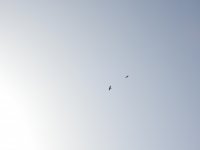I've been watching a pair of Goshawks over a wood not far from me over Spring, often not up together but occasionally they do get up at the same time and almost seem to fight each other, stooping at each other with talons out. But they don't connect. I am presuming these 2 adults are a breeding pair. They have also been stooping and doing the rollercoaster display occasionally, but mostly just circling gradually to a mile away and then back again.
It has provided me great opportunity to study the species closely, alongside up to 12 Buzzards, Red Kite, Peregrine, 2 Sparrowhawks, Kestrel, and several Ravens, as well as lots of Crows and Jackdaws. There is also a resident Little Owl pair, plus lots of Pheasants, Red-legged Partridges, Lapwings, Skylarks, Meadow Pipits, tits, Blackbirds, Song and Mistle Thrushes, Chaffinches, plus occasional Yellowhammer, Reed Bunting, Goldfinch, Greenfinch. A large wintering flock of Fieldfares and Redwings have now moved on.
The female Gos is clearly larger than the male, a crow that had a go at it was two-thirds its size. I would say the female was equal size to the Buzzards present, quite long-bodied almost like a Honey Buzzard but always wings held flat and like a flying crucifix. The male Gos is smaller, about a third smaller than the female and with more rapid wing beats but still clearly a Gos, bulky and broad-chested and like the female with a tapering trailing edge to the wings (in contrast to Sparrowhawks). Its markings are darker grey/blue than the female and the eye-stripe is visible giving a clear capped effect. The sun angle is often poor from the spot I observe. Interestingly, when we recently had two days of really warm weather, another 2 Goshawks came up from the large wood, an immature female and another bird which I didn't get good looks at, but probably an immature male. I had never seen them previously but to have 4 Gos's in the air at the same time was fantastic, but only on that single day. Every other time I have just seen the adult pair, literally every day I have been in March. I am sure all 4 birds are present all the time, but if not breeding there will unlikely be any display.
Fantastic birds! I am really chuffed as I usually have to drive to Forest of Dean or maybe Wrye Forest to see Gos's, but this year they are present near to me.






